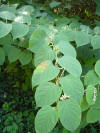WILD
FOODIES' HOME PAGE
PLANT PROFILE LIST
NAME: Japanese Knotweed
SPECIES / FAMILY: Fallopia Japonica / Polygonaceae
OTHER COMMON NAME(S): Mexican Bamboo
CONDITIONS:
sun/shade, almost any soil condition
|
PARTS: |
EDIBLE |
TASTE |
RAW/COOK |
SEASON |
|
All |
|
|
|
|
|
Shoots |
|
lemony |
COOK |
Spring |
|
Leaves |
|
lemony |
COOK |
Spring/Summer |
|
Stalk/Stem |
|
lemony |
PEEL/COOK |
Spring/Summer |
|
Buds |
||||
|
Flowers |
|
|
|
|
|
Fruits |
|
|
|
|
|
Pods |
|
|||
|
Seeds |
|
|
RAW/COOK |
Summer |
|
Nuts |
|
|
|
|
|
Roots |
|
|
|
|
|
Bark |
|
|
|
|
PORTION: medium
COMMENT: This is a great veggie in its own right, or you can think of it as a substitute for Rhubarb. It starts coming up as early as March. Just snap off the early shoots at about 7 inches tall. Cook like asparagus, steam or put in boiling water, throw off the water once if too bitter. // Young shoots - acid flavour used as a rhubarb substitute in pies, fruit soups, jams etc. Older stems and shoot tips – cooked, mild version of rhubarb. Seed - ground into a powder and used as a flavouring and thickener in soups etc, or can be mixed with cereals when making bread, cakes etc.(1)
CAUTION: Although no specific mention has been made for this species, there have been reports that some members of this genus can cause photosensitivity in susceptible people. Many species also contain oxalic acid, boil with lid off to minimize.(1)
NUTRITION/MEDICINAL: Antiphlogistic; Antitumor; Depurative; Diuretic; Emollient; Febrifuge; Stomachic; Vulnerary;
Women's complaints. The root is antiphlogistic, bechic, depurative, diuretic, emmenagogue, emollient, febrifuge, stomachic and vulnerary. It is also used in the treatment of women's complaints. A decoction is used in the treatment of burn injuries, boils and abscesses, poisonous snakebites, acute hepatitis, appendicitis, traumatic injuries and menstrual irregularities. The leaves can be crushed and applied externally as a poultice to abscesses, cuts etc, whilst the dried roots can be ground into a powder and applied externally. Extracts of the plant have shown antitumour activity. (1) Roots used for Lyme’s disease recovery with other herbs and remedies - http://www.mvlymecenter.org/2013/04/27/lyme-stories-steve-cabana-how-i-got-well
LOOK-A-LIKES:
POISONOUS LOOK-A-LIKES:
OTHER USES:
SOURCE LINKS (may include nutritional and medicinal info, plus other uses):
- https://pfaf.org/user/Plant.aspx?LatinName=Reynoutria+japonica
- http://www.eattheweeds.com/japanese-knotweed-dreadable-edible
- https://en.wikipedia.org/wiki/Fallopia_japonica
- http://www.ediblewildfood.com/japanese-knotweed.aspx (good photos)
- https://www.bonappetit.com/test-kitchen/ingredients/article/japanese-knotweed-recipes (recipe)
- http://foragerchef.com/japanese-knotweed (recipe)
- https://www.thespruceeats.com/japanese-knotweed-pickles-1337865 (recipe)
- http://ledameredith.com/japanese-knotweed-bars-wild-food-recipe (recipe)
- http://tacticalintelligence.net/blog/wild-edibles-how-to-eat-japanese-knotweed.htm (recipe)
- http://eattheinvaders.org/japanese-knotweed (recipe)
- https://www.theguardian.com/lifeandstyle/shortcuts/2018/may/30/is-japanese-knotweed-driving-you-wild-dont-curse-it-cook-it (recipe)
- https://sites.google.com/site/groceryalternative/edible-plants/japanese-knotweed
- Philly's POP https://www.phillyorchards.org/wp-content/uploads/2019/04/Japanese-Knotweed-Info-Sheet.pdf



